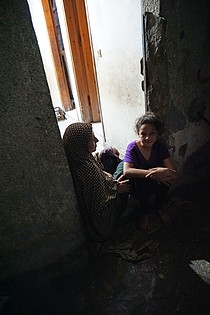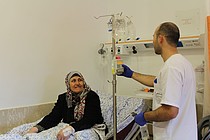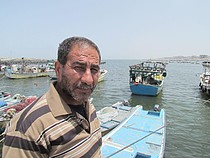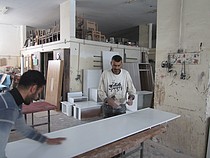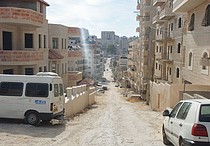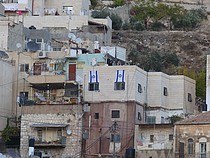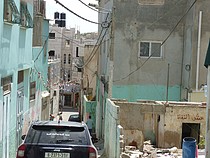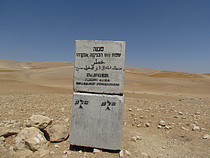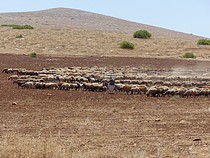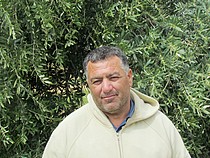For the past decade, the Gaza Strip has suffered from a chronic electricity deficit that has undermined its already fragile living conditions. The functioning of Gaza’s sole power plant (GPP) is impaired by disputes between the Palestinian authorities in Gaza and Ramallah over the funding and taxation of fuel; the inadequate collection of bills from consumers; the destruction of fuel storage tanks by an Israeli strike in July 2014; and Israeli restrictions on imports of spare parts and equipment, citing security concerns. In April 2017 the GPP shut down completely after exhausting its fuel reserves. It resumed partial operations in late June with fuel purchased from Egypt. Gaza also relies on the purchase of electricity from Israel and Egypt.
The Monthly Humanitarian Bulletin | May-June 2017
Special edition

This Humanitarian Bulletin coincides with the 50th anniversary of the June 1967 war and the start of Israel’s occupation of the West Bank, including East Jerusalem, and the Gaza Strip. To mark the occasion, this issue revisits the cases of ten Palestinians who featured in previous OCHA publications, to illustrate some of the enduring humanitarian concerns in the OPT.
Of particular concern these days is the aggravation of Gaza’s chronic electricity crisis, which has undermined already precarious living conditions over the past decade. The drivers of this problem in recent years have included internal Palestinian disputes; limited collection of bills from consumers and related funding shortages to run Gaza’s sole power plant (GPP); the destruction of electricity-related facilities by Israeli airstrikes; and Israeli restrictions on the import of spare parts and equipment, citing security concerns.
The case of Siham al Tatari, Gaza City
In June 2007, following the takeover of the Gaza Strip by Hamas and citing security concerns, Israel imposed a land, sea and air blockade on Gaza that intensified previous access restrictions. Along with the closure of the Rafah crossing by Egypt, the blockade ‘locked in’ nearly two million Palestinians in Gaza, unable to access the remainder of the OPT and the outside world. Exceptions are made for certain categories, including medical patients and their companions who must apply for a permit from the Israeli authorities to cross via the Erez crossing.
The case of Abdallah al ‘Abasi from Ash Shati Refugee Camp, Gaza
Since September 2000, Israel has tightened restrictions on Palestinian access to the sea, citing security concerns. These restrictions have been enforced through the firing of live ammunition, arrests and the confiscation of equipment. While sea restrictions have varied, since 2006 fishermen have generally been allowed to access less than one third of the fishing areas allocated to them under the Oslo Accords: six out of 20 nautical miles (NM), although this has temporarily been extended to nine NM during the sardine season in recent years.
The case of Mujahed Al Sousy from Jabalia, Gaza
As part of the blockade imposed in 2007 following the takeover of the Gaza Strip by Hamas, Israel completely banned exports. This resulted in a dramatic decline in manufacturing activities and a rise in unemployment. In 2010, the export ban was eased slightly to allow the exit of minimal quantities of goods, primarily cut flowers and strawberries to overseas markets only. Following the 2014 conflict, commercial transfers from Gaza to the West Bank resumed, first for agricultural produce and later for textiles and furniture; after March 2015, limited exports were also permitted from Gaza to Israel.
The case of Samih Abu Ramila, from Kafr ‘Aqab, East Jerusalem
Following a wave of Palestinian attacks, including suicide bombings, Israel began building a Barrier in 2002 with the stated aim of preventing such attacks. The Barrier’s deviation from the Israeli-declared municipal boundary of Jerusalem has resulted in some Palestinian localities in East Jerusalem, especially Kafr Aqab and Shufat camp area, becoming separated from the urban centre. Although residents retain their permanent residency status and continue to pay municipal taxes, these areas have effectively been abandoned by the municipality.
The case of Suhaib Al Awar from Silwan, East Jerusalem
For the past three years, approximately 700 Palestinian children in East Jerusalem have been detained by Israeli forces every year, usually on charges of stone-throwing and, more recently, incitement to violence in social media. Some of these cases have triggered allegations of abuses during the arrest, transfer and/or interrogation. Also of concern are recent changes to Israeli legislation that allow harsher prison sentences for children convicted of crimes such as stone-throwing, including children as young as 12 who start serving their sentences when they turn 14. Some Palestinian children convicted or awaiting trial have been placed under house arrest. Although preferable than imprisonment for children, this puts additional strain on the families affected.
Mohammed Al Ammasi from Al Fawwar refugee camp, Hebron
Violent clashes between Israeli forces and Palestinian civilians in the West Bank, primarily during demonstrations and search and arrest operations, have been on the rise in recent years. In 2016, 19 Palestinians were killed and over 3,200 injured during such clashes; nearly 14 per cent of these injuries were from live ammunition. Serious injuries often result in long-term disability, rendering young Palestinians in constant need of medical treatment and humanitarian assistance, and disrupting the lives of their entire families.
The case of Khaled Al ‘Amoor from Khirbet Sarura – Masafer Yatta, Hebron
Since the 1970s, Israel has declared some 18 per cent of the West Bank, or nearly 30 per cent of Area C, as firing zones for military training. A presence in these zones is prohibited by military order unless special permission is granted. Despite this prohibition, there are 38 small Palestinian herding communities with a population of over 6,200 located within these zones. Many of these communities existed in the area prior to its closure.
The case of Abdul Rahim Bisharat, Al Hadidiya, Tubas
The restrictive planning regime applied in Area C, which comprises over 60 per cent of the West Bank and where Israel retains near exclusive control, makes it virtually impossible for Palestinians to obtain building permits. This prevents them from developing basic services in their communities, including education. Over a third of the residential areas in Area C (189 out of 532) lack a primary school and children are forced to travel long distances, sometimes on foot, to reach the nearest school.
The case of Tayseer Amarneh from Akkaba, Tulkarm
In 2002, following a wave of Palestinian attacks, including suicide bombings, Israel began building a Barrier with the stated aim of preventing these attacks. The vast majority of the Barrier’s route is located within the West Bank; it separates Palestinian communities and farming land from the rest of the West Bank, and contributes to the fragmentation of the OPT.
In this document
For the past three years, approximately 700 Palestinian children in East Jerusalem have been detained by Israeli forces every year, usually on charges of stone-throwing and, more recently, incitement to violence in social media. Some of these cases have triggered allegations of abuses during the arrest, transfer and/or interrogation. Also of concern are recent changes to Israeli legislation that allow harsher prison sentences for children convicted of crimes such as stone-throwing, including children as young as 12 who start serving their sentences when they turn 14. Some Palestinian children convicted or awaiting trial have been placed under house arrest. Although preferable than imprisonment for children, this puts additional strain on the families affected.
As part of the blockade imposed in 2007 following the takeover of the Gaza Strip by Hamas, Israel completely banned exports. This resulted in a dramatic decline in manufacturing activities and a rise in unemployment. In 2010, the export ban was eased slightly to allow the exit of minimal quantities of goods, primarily cut flowers and strawberries to overseas markets only. Following the 2014 conflict, commercial transfers from Gaza to the West Bank resumed, first for agricultural produce and later for textiles and furniture; after March 2015, limited exports were also permitted from Gaza to Israel.
The restrictive planning regime applied in Area C, which comprises over 60 per cent of the West Bank and where Israel retains near exclusive control, makes it virtually impossible for Palestinians to obtain building permits. This prevents them from developing basic services in their communities, including education. Over a third of the residential areas in Area C (189 out of 532) lack a primary school and children are forced to travel long distances, sometimes on foot, to reach the nearest school.
In June 2007, following the takeover of the Gaza Strip by Hamas and citing security concerns, Israel imposed a land, sea and air blockade on Gaza that intensified previous access restrictions. Along with the closure of the Rafah crossing by Egypt, the blockade ‘locked in’ nearly two million Palestinians in Gaza, unable to access the remainder of the oPt and the outside world. Exceptions are made for certain categories, including medical patients and their companions who must apply for a permit from the Israeli authorities to cross via the Erez crossing.
Violent clashes between Israeli forces and Palestinian civilians in the West Bank, primarily during demonstrations and search and arrest operations, have been on the rise in recent years. In 2016, 19 Palestinians were killed and over 3,200 injured during such clashes; nearly 14 per cent of these injuries were from live ammunition. Serious injuries often result in long-term disability, rendering young Palestinians in constant need of medical treatment and humanitarian assistance, and disrupting the lives of their entire families.
This Humanitarian Bulletin coincides with the 50th anniversary of the June 1967 war and the start of Israel’s occupation of the West Bank, including East Jerusalem, and the Gaza Strip. To mark the occasion, this issue revisits the cases of ten Palestinians who featured in previous OCHA publications, to illustrate some of the enduring humanitarian concerns in the oPt
Following a wave of Palestinian attacks, including suicide bombings, Israel began building a Barrier in 2002 with the stated aim of preventing such attacks. The Barrier’s deviation from the Israeli-declared municipal boundary of Jerusalem has resulted in some Palestinian localities in East Jerusalem, especially Kafr Aqab and Shufat camp area, becoming separated from the urban centre. Although residents retain their permanent residency status and continue to pay municipal taxes, these areas have effectively been abandoned by the municipality.
